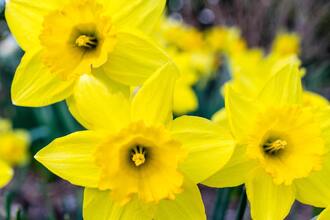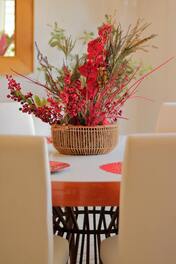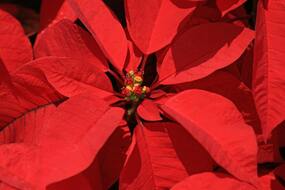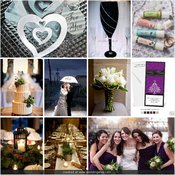 Daffodils, That come before the swallow dares, and take The winds of March with beauty. –William Shakespere, The Winter's Tale Usually thought of as a spring flower, and for good reason, Daffodils are ususlly seen in season starting in late December and lasting though April. I am always very happy to see the first Daffodil blooms, sometimes there is still a bit of snow on the ground when they start to poke through. This is always a sure sing to me that winter will soon be just a memory. Common Name: Daffodil Botanical Name: Narcissus Pseudonarcissus (nar-SIS-is sue-do-nar-SIS-is) Once again due to the wonders of greenhouses and the advancements in growing techniques, Daffodils are available wholesale year round as a cut flowers. There are as many as 60 different varieties grown in white, yellow and bi-color. Daffodils can have a single or double 1-3" corona white a 3-4" star-shaped back atop a 8-22' hollow stem. They are sure to add a cheerful feel to any arrangement. There are several possible stories on how/where the daffodil gets its name. One of the most common relates to the story of the young man of Greek mythology named Narcissus, who became so obsessed with his own reflection that as he knelt and gazed into a pool of water, he fell into the water and drowned. In some variations, he died of starvation and thirst from sitting by the edge of the pool, transfixed by his own reflection. In both versions, the Narcissus plant sprang from where he died. When cut, the trick is to keep the daffodils alone in a vase. Their stems secrete a sap that promotes the wilting of other flowers. If you must combine them, soak them by themselves for as long as possible, then rinse them and add them to the arrangement last without re-cutting the stems. Interesting Fact: Daffodils are grown commercially near Brecon in Powys, Wales, to produce galantamine, a drug used to combat Alzheimer's disease.
0 Comments
 So have you finished all your Christmas shopping? Or do you like to wait for the last minute rush? Either way Christmas is such a wonderful, magical time of year. I love sharing holiday traditions with my children, making cookies, decorating the tree and putting up the Nativity set. But most of all, I love seeing all my family. And what better way to make someone specila in your life feel extra treasured then to send them flowers. Even if you already bought their gift or if you are stuck for a last minute gift, send flowers! It sends the message of love and brightens the receivers home. Or better yet sign your loved one up for a flowers of the month club and your gift will be the one that keeps on giving. The best part, the size will always fit. If you want to send flowers this holiday call us or your local florist, we are here to help. What is your favorite tradition/reason for the season? Did you buy a Poinsettia this year? I did. It is one of my favorite holiday flowers. So I wanted to share with you a reprint of an earlier blog of mine regarding the lovely Poinsettia.  With Christmas right around the corner I thought I would share some information about a plant we will all be seeing a lot of very soon, the poinsettia. Poinsettias come in a variety of colors from traditional red and white to dyed purple, blue and even green and gold. Common Name: Poinsettia Botanical Name: Euphorbia pulcherrima With its beautiful star-shape, poinsettia is a popular Christmas flower. In Central America it is called the "Flame Leaf" or "Flower of the Holy Night". A native of Mexico, it was brought here over a hundred years ago by Dr. Joel Poinsett, the first US ambassador to Mexico. Most of the poinsettias used these days come from California. The legend of the poinsettia comes from Mexico. It tells of a girl named Maria and her little brother Pablo. They were very poor but always looked forward to the Christmas festival. Each year a large manger scene was set up in the village church, and the days before Christmas were filled with parades and parties. The two children loved Christmas but were always saddened because they had no money to buy presents. They especially wished that they could give something to the church for the Baby Jesus. But they had nothing. One Christmas Eve, Maria and Pablo set out for church to attend the service. On their way they picked some weeds growing along the roadside and decided to take them as their gift to the Baby Jesus in the manger scene. Of course they were teased by other children when they arrived with their gift, but they said nothing for they knew they had given what they could. Maria and Pablo began placing the green plants around the manger and miraculously, the green top leaves turned into bright red petals, and soon the manger was surrounded by beautiful star-like flowers and so we see them today. Interesting Fact: The Poinsettia is NOT poisonous. It is mildly irritating to the skin or stomach and may sometimes cause diarrhea and vomiting if eaten. Sap in the eye may even cause temporary blindness but no fatalities have ever been documented. While it is true that the plant is not very toxic, those sensitive to latex may suffer an allergic reaction and it is therefore not advisable to bring the plants into the home of sensitive individuals. The origin of this myth could be found in the fact that many plants of the spurge genus are indeed toxic. This misconception was spread by a 1919 urban legend of a two-year-old child dying after consuming a poinsettia leaf. |
AuthorFaye K.-Owner/Designer at Blooming Envy since 2005. Categories
All
|



 RSS Feed
RSS Feed